HRM Report: Strategies for Effective Human Resource Management
VerifiedAdded on 2020/06/05
|20
|4250
|67
Report
AI Summary
This report provides a comprehensive overview of Human Resource Management (HRM), beginning with an exploration of the stages of human resource planning and the differences between personnel management and HRM. It outlines the roles and responsibilities of HR managers and analyzes a case study involving a company with traditional HR practices. The report explains a mind map of HRM functions, emphasizing operative, managerial, and advisory roles. It highlights the importance of human resource planning in addressing issues like high attrition rates and low employee morale. Furthermore, it suggests a new performance and reward system to boost motivation and job satisfaction. The report concludes with a summary of key findings and provides a bibliography of cited sources.
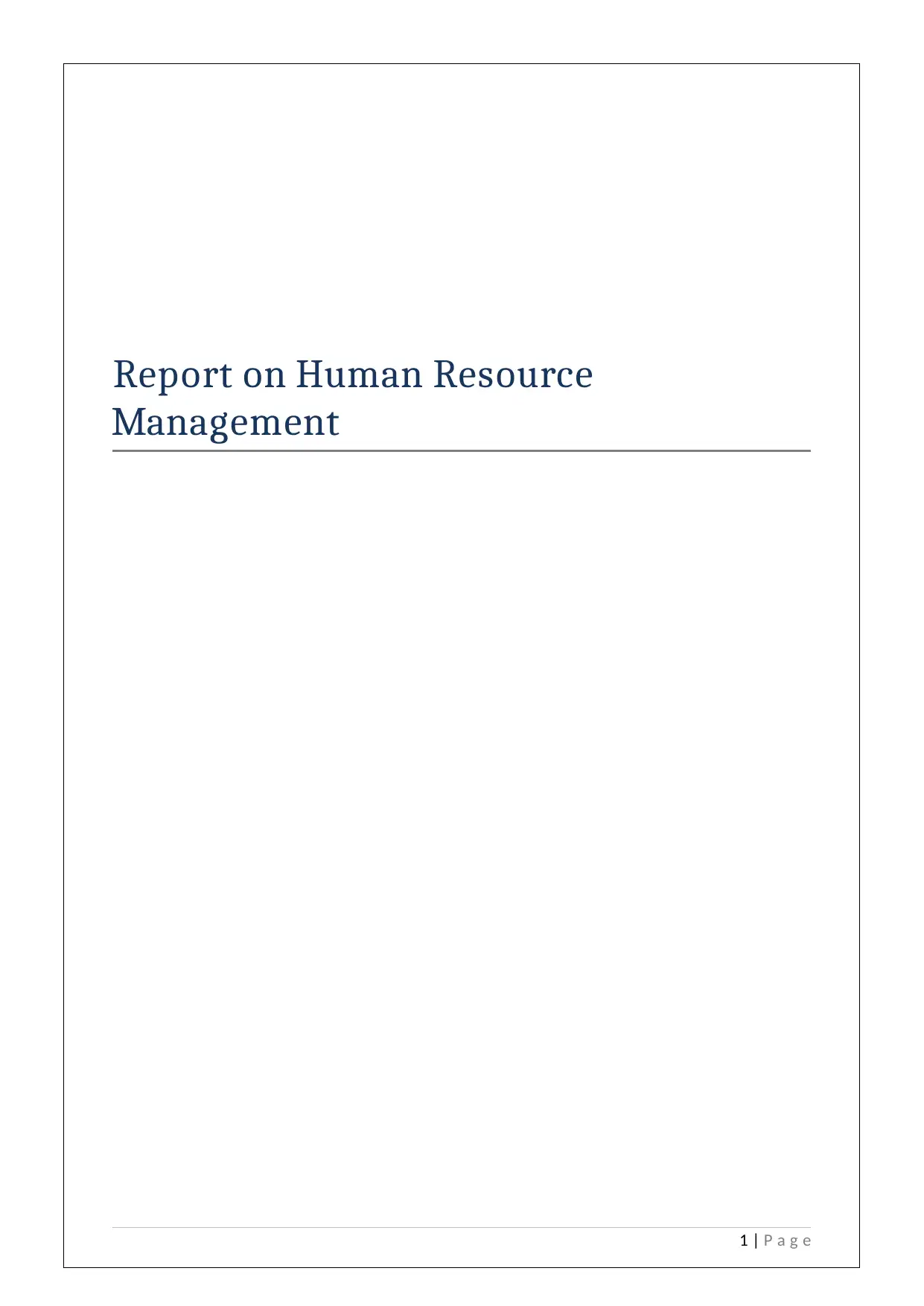
Report on Human Resource
Management
1 | P a g e
Management
1 | P a g e
Paraphrase This Document
Need a fresh take? Get an instant paraphrase of this document with our AI Paraphraser
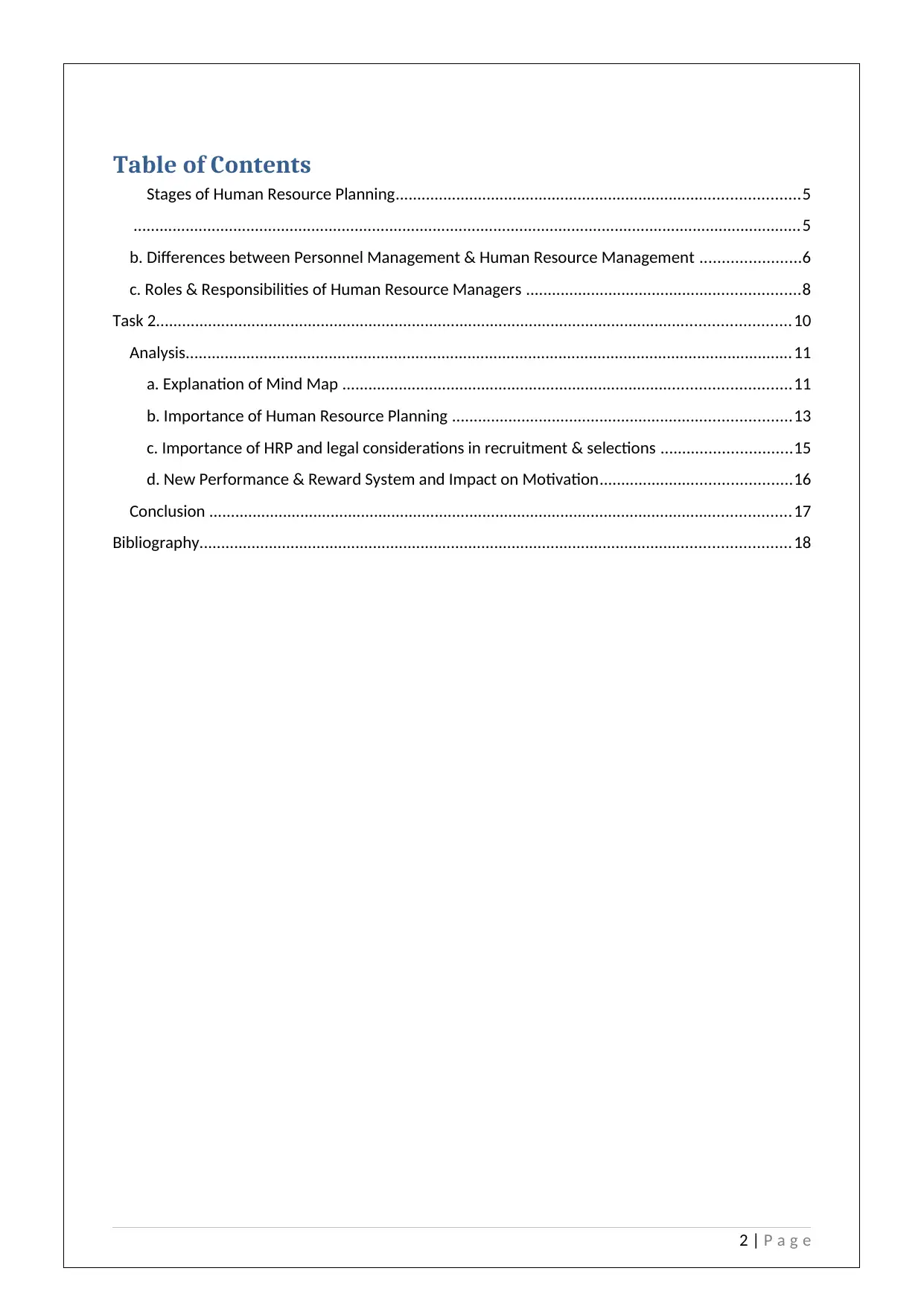
Table of Contents
Stages of Human Resource Planning.............................................................................................5
..........................................................................................................................................................5
b. Differences between Personnel Management & Human Resource Management .......................6
c. Roles & Responsibilities of Human Resource Managers ...............................................................8
Task 2..................................................................................................................................................10
Analysis............................................................................................................................................11
a. Explanation of Mind Map .......................................................................................................11
b. Importance of Human Resource Planning ..............................................................................13
c. Importance of HRP and legal considerations in recruitment & selections ..............................15
d. New Performance & Reward System and Impact on Motivation............................................16
Conclusion ......................................................................................................................................17
Bibliography........................................................................................................................................18
2 | P a g e
Stages of Human Resource Planning.............................................................................................5
..........................................................................................................................................................5
b. Differences between Personnel Management & Human Resource Management .......................6
c. Roles & Responsibilities of Human Resource Managers ...............................................................8
Task 2..................................................................................................................................................10
Analysis............................................................................................................................................11
a. Explanation of Mind Map .......................................................................................................11
b. Importance of Human Resource Planning ..............................................................................13
c. Importance of HRP and legal considerations in recruitment & selections ..............................15
d. New Performance & Reward System and Impact on Motivation............................................16
Conclusion ......................................................................................................................................17
Bibliography........................................................................................................................................18
2 | P a g e
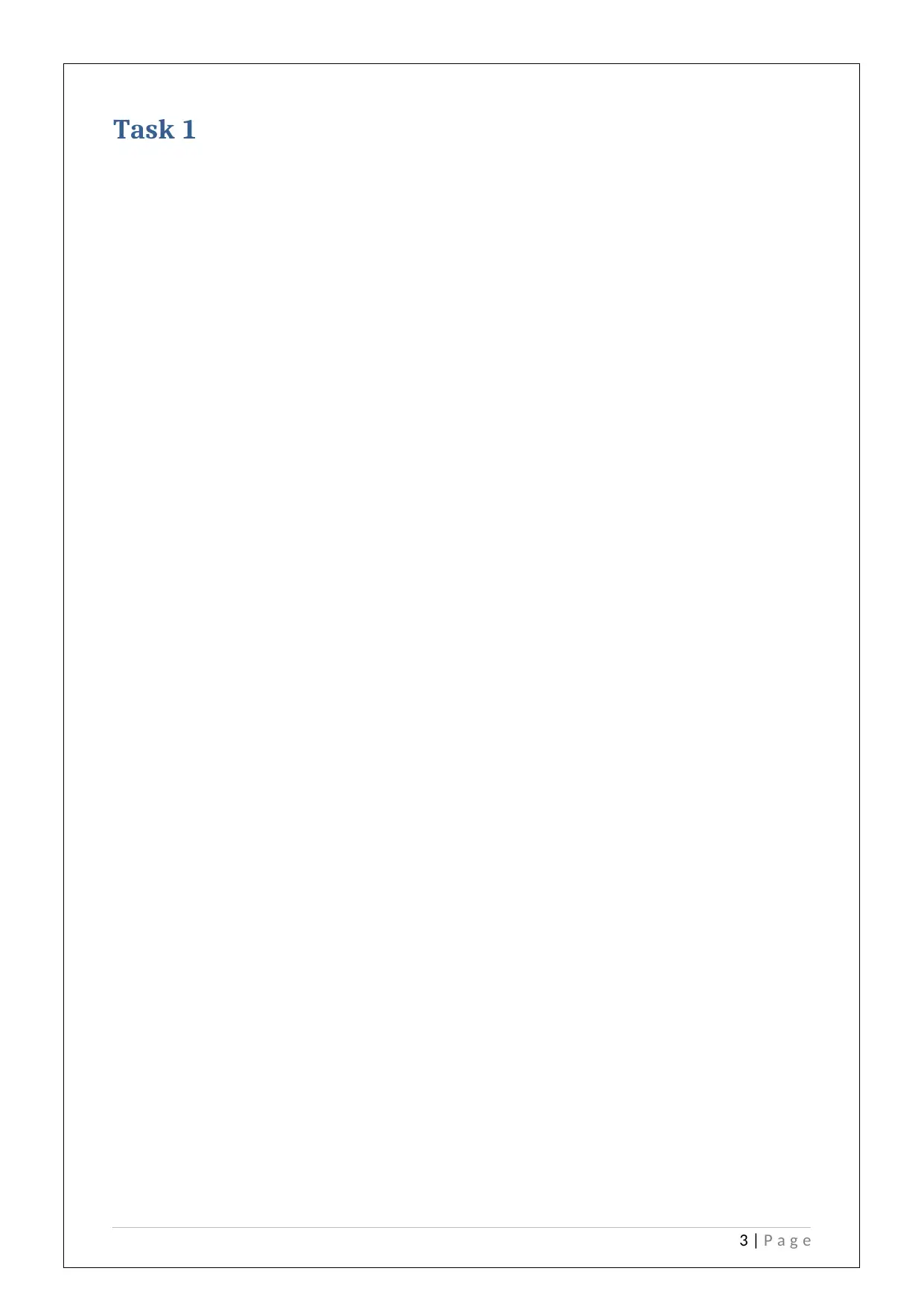
Task 1
3 | P a g e
3 | P a g e
⊘ This is a preview!⊘
Do you want full access?
Subscribe today to unlock all pages.

Trusted by 1+ million students worldwide
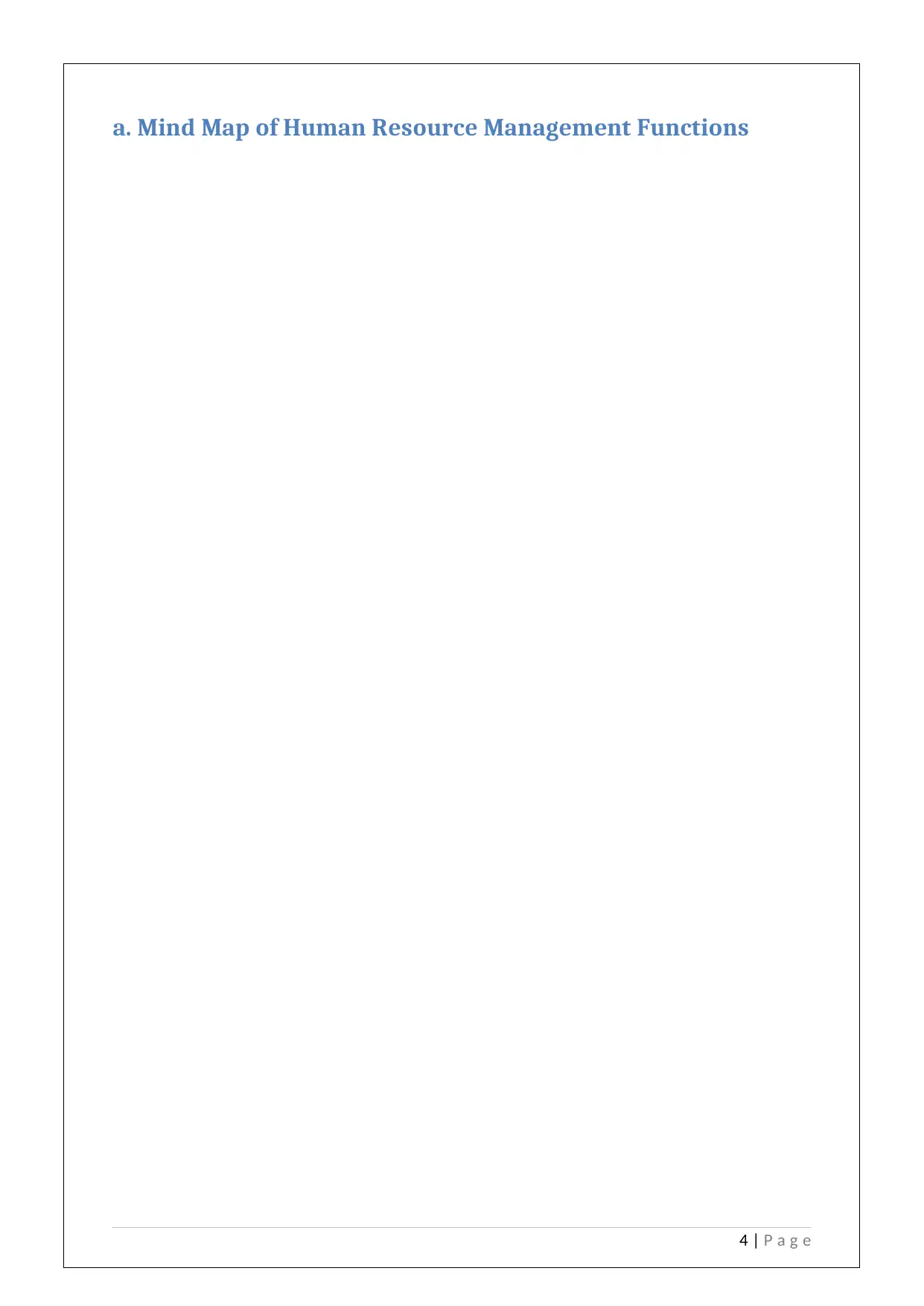
a. Mind Map of Human Resource Management Functions
4 | P a g e
4 | P a g e
Paraphrase This Document
Need a fresh take? Get an instant paraphrase of this document with our AI Paraphraser
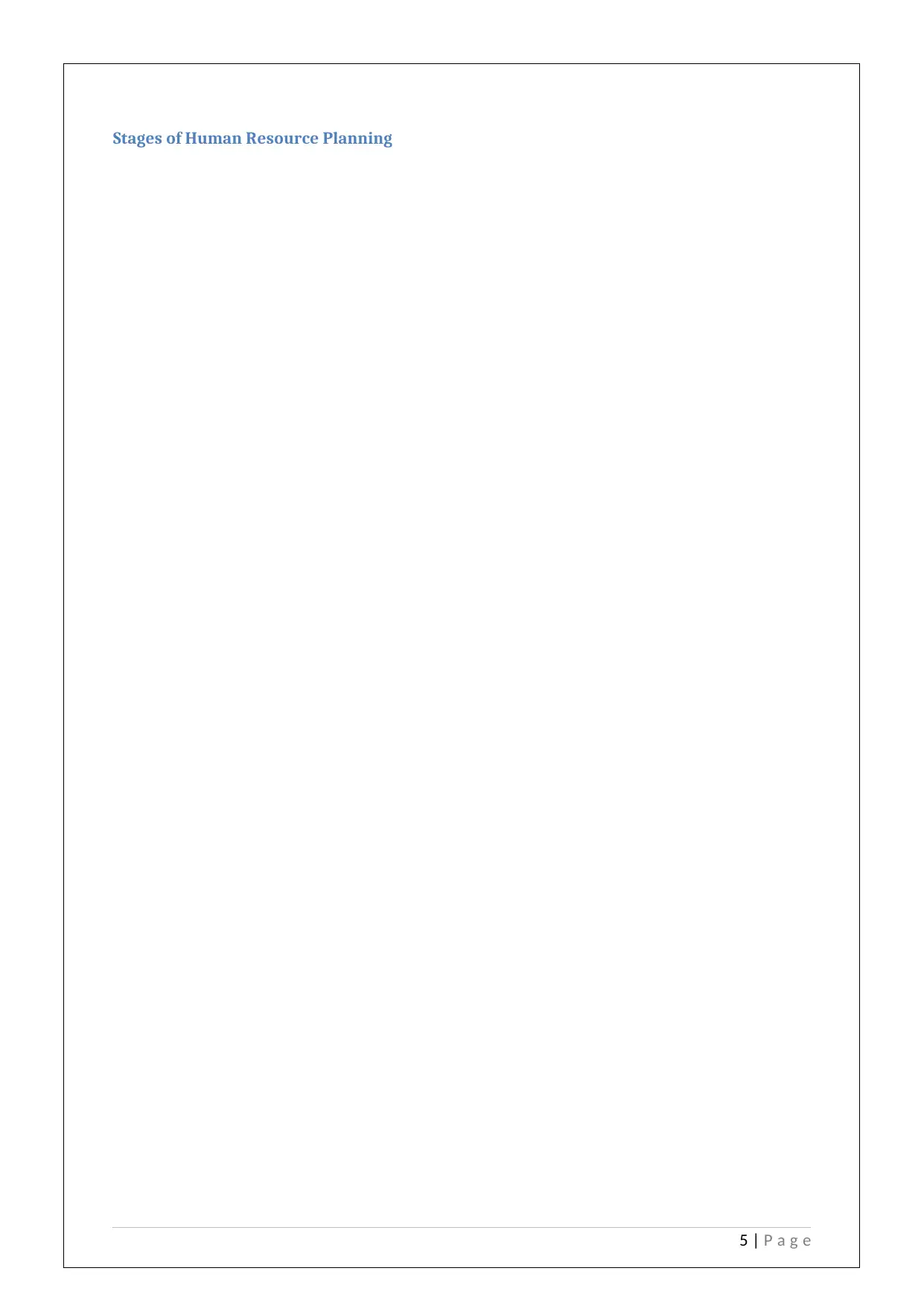
Stages of Human Resource Planning
5 | P a g e
5 | P a g e
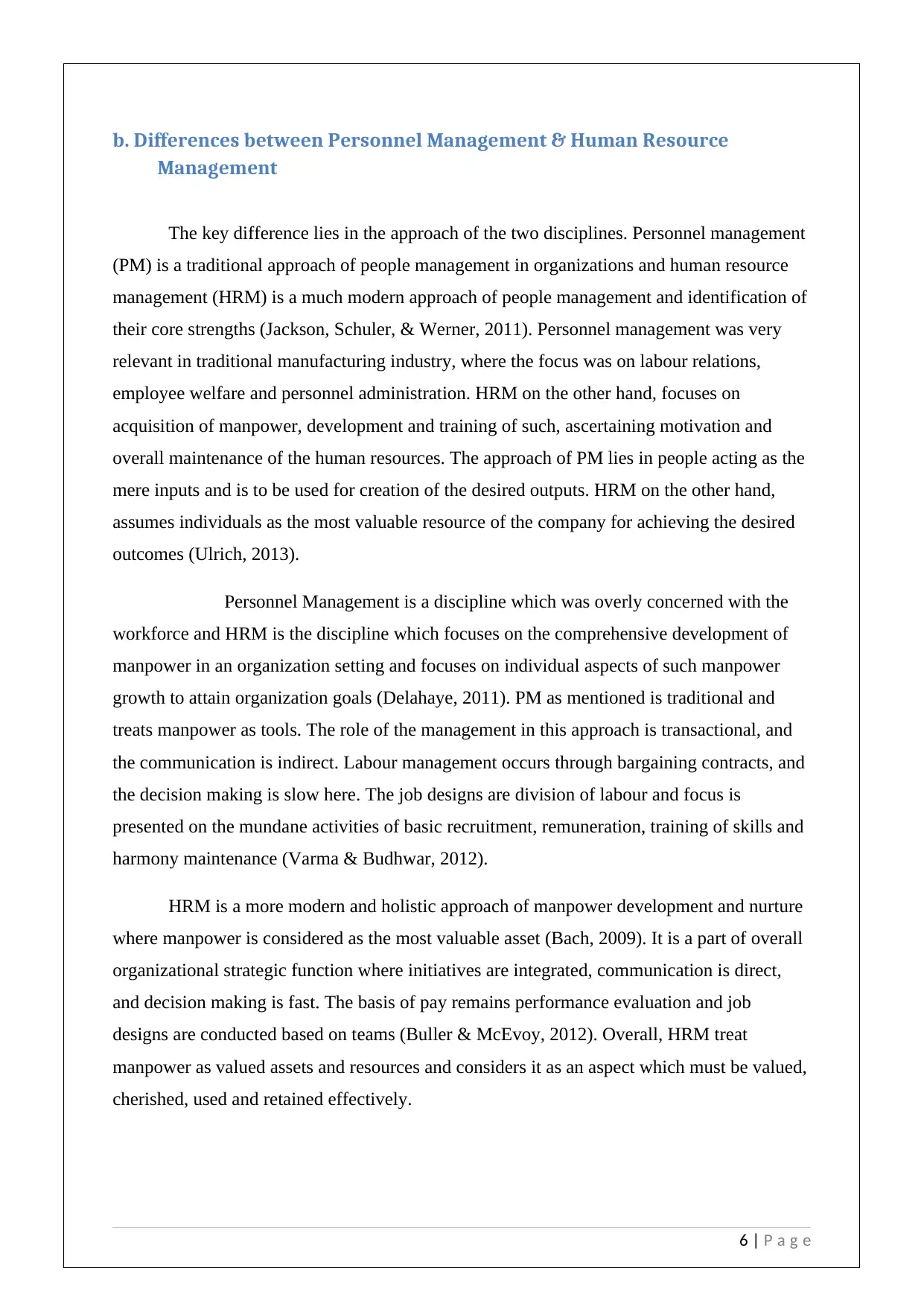
b. Differences between Personnel Management & Human Resource
Management
The key difference lies in the approach of the two disciplines. Personnel management
(PM) is a traditional approach of people management in organizations and human resource
management (HRM) is a much modern approach of people management and identification of
their core strengths (Jackson, Schuler, & Werner, 2011). Personnel management was very
relevant in traditional manufacturing industry, where the focus was on labour relations,
employee welfare and personnel administration. HRM on the other hand, focuses on
acquisition of manpower, development and training of such, ascertaining motivation and
overall maintenance of the human resources. The approach of PM lies in people acting as the
mere inputs and is to be used for creation of the desired outputs. HRM on the other hand,
assumes individuals as the most valuable resource of the company for achieving the desired
outcomes (Ulrich, 2013).
Personnel Management is a discipline which was overly concerned with the
workforce and HRM is the discipline which focuses on the comprehensive development of
manpower in an organization setting and focuses on individual aspects of such manpower
growth to attain organization goals (Delahaye, 2011). PM as mentioned is traditional and
treats manpower as tools. The role of the management in this approach is transactional, and
the communication is indirect. Labour management occurs through bargaining contracts, and
the decision making is slow here. The job designs are division of labour and focus is
presented on the mundane activities of basic recruitment, remuneration, training of skills and
harmony maintenance (Varma & Budhwar, 2012).
HRM is a more modern and holistic approach of manpower development and nurture
where manpower is considered as the most valuable asset (Bach, 2009). It is a part of overall
organizational strategic function where initiatives are integrated, communication is direct,
and decision making is fast. The basis of pay remains performance evaluation and job
designs are conducted based on teams (Buller & McEvoy, 2012). Overall, HRM treat
manpower as valued assets and resources and considers it as an aspect which must be valued,
cherished, used and retained effectively.
6 | P a g e
Management
The key difference lies in the approach of the two disciplines. Personnel management
(PM) is a traditional approach of people management in organizations and human resource
management (HRM) is a much modern approach of people management and identification of
their core strengths (Jackson, Schuler, & Werner, 2011). Personnel management was very
relevant in traditional manufacturing industry, where the focus was on labour relations,
employee welfare and personnel administration. HRM on the other hand, focuses on
acquisition of manpower, development and training of such, ascertaining motivation and
overall maintenance of the human resources. The approach of PM lies in people acting as the
mere inputs and is to be used for creation of the desired outputs. HRM on the other hand,
assumes individuals as the most valuable resource of the company for achieving the desired
outcomes (Ulrich, 2013).
Personnel Management is a discipline which was overly concerned with the
workforce and HRM is the discipline which focuses on the comprehensive development of
manpower in an organization setting and focuses on individual aspects of such manpower
growth to attain organization goals (Delahaye, 2011). PM as mentioned is traditional and
treats manpower as tools. The role of the management in this approach is transactional, and
the communication is indirect. Labour management occurs through bargaining contracts, and
the decision making is slow here. The job designs are division of labour and focus is
presented on the mundane activities of basic recruitment, remuneration, training of skills and
harmony maintenance (Varma & Budhwar, 2012).
HRM is a more modern and holistic approach of manpower development and nurture
where manpower is considered as the most valuable asset (Bach, 2009). It is a part of overall
organizational strategic function where initiatives are integrated, communication is direct,
and decision making is fast. The basis of pay remains performance evaluation and job
designs are conducted based on teams (Buller & McEvoy, 2012). Overall, HRM treat
manpower as valued assets and resources and considers it as an aspect which must be valued,
cherished, used and retained effectively.
6 | P a g e
⊘ This is a preview!⊘
Do you want full access?
Subscribe today to unlock all pages.

Trusted by 1+ million students worldwide
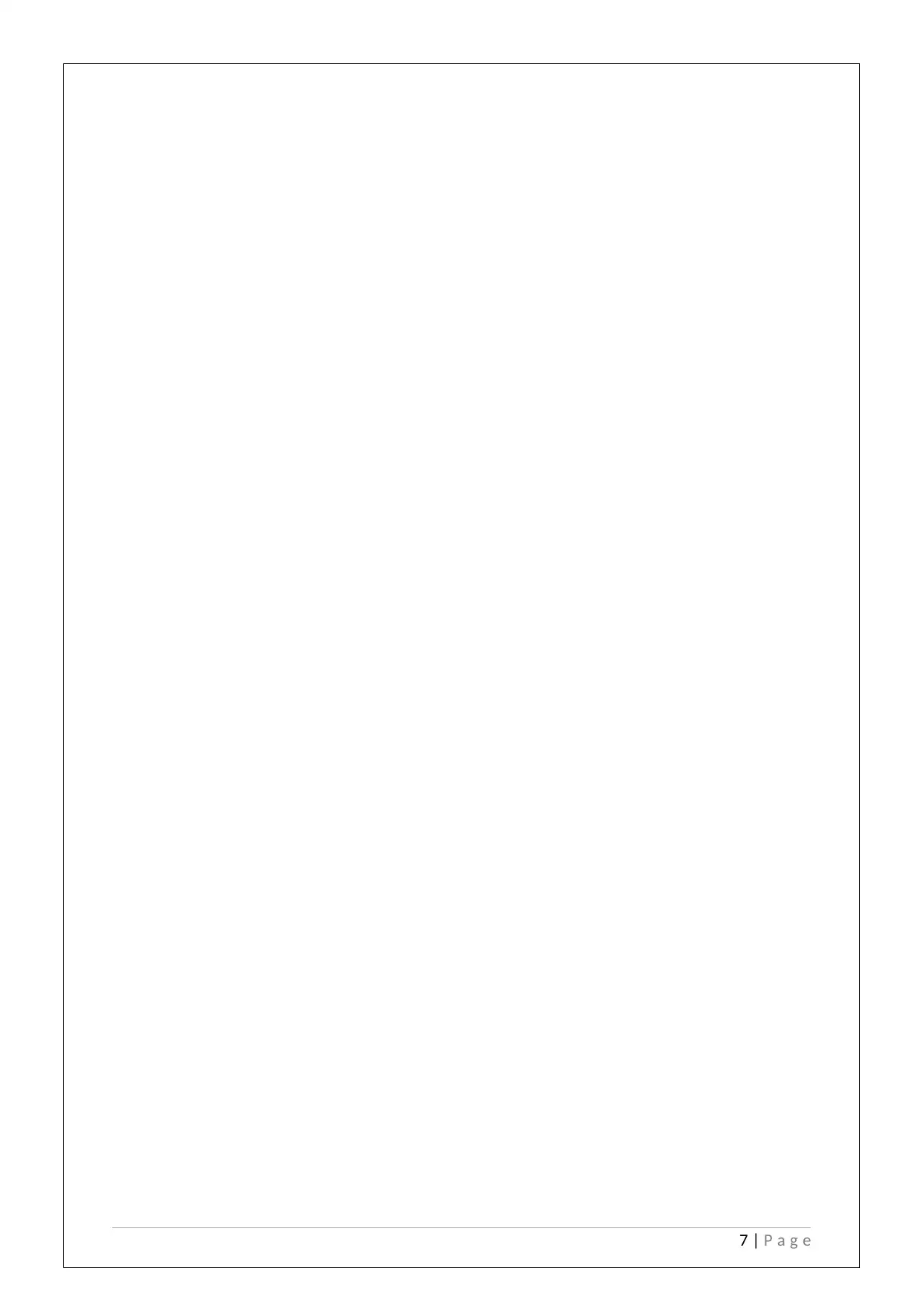
7 | P a g e
Paraphrase This Document
Need a fresh take? Get an instant paraphrase of this document with our AI Paraphraser
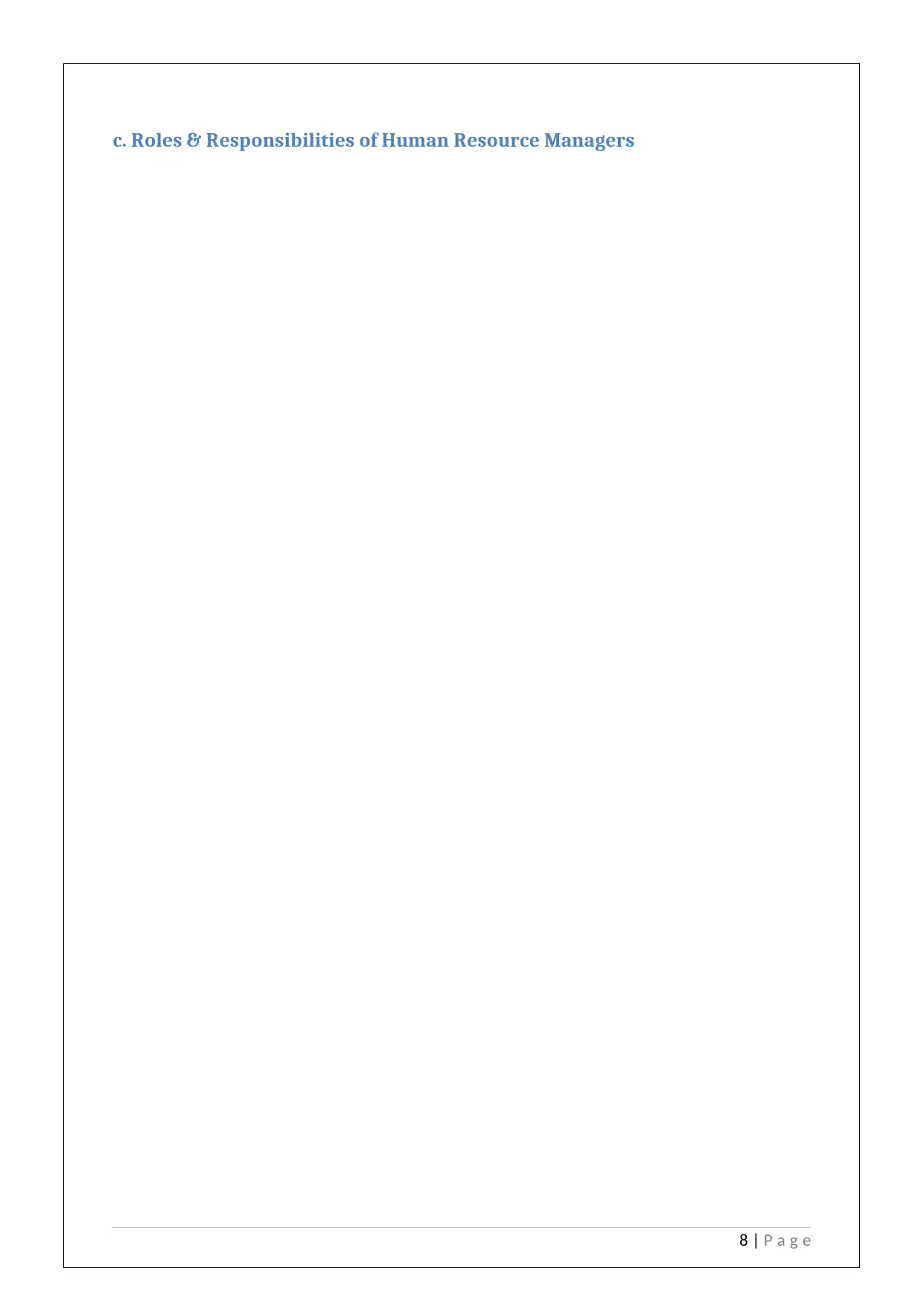
c. Roles & Responsibilities of Human Resource Managers
8 | P a g e
8 | P a g e
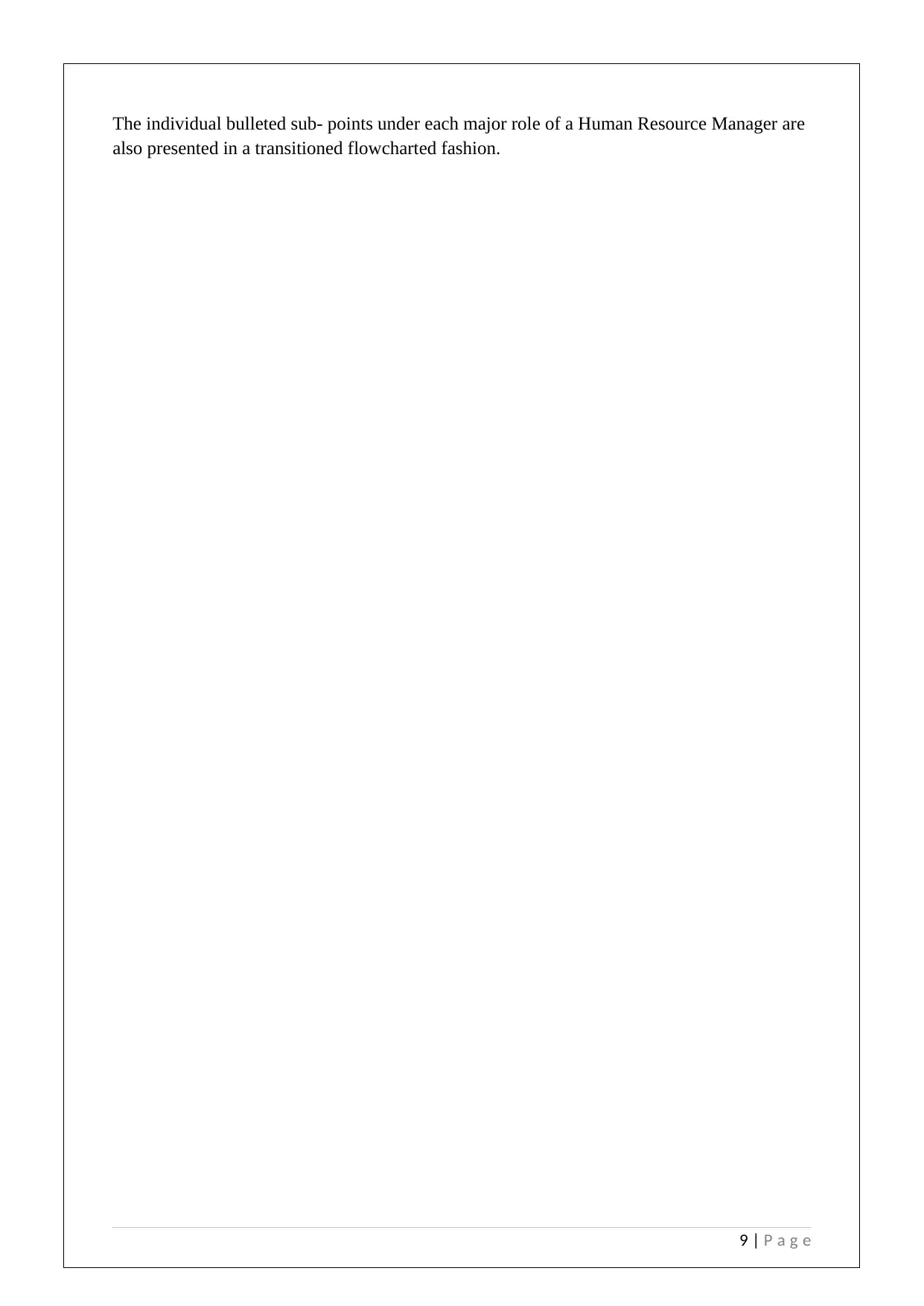
The individual bulleted sub- points under each major role of a Human Resource Manager are
also presented in a transitioned flowcharted fashion.
9 | P a g e
also presented in a transitioned flowcharted fashion.
9 | P a g e
⊘ This is a preview!⊘
Do you want full access?
Subscribe today to unlock all pages.

Trusted by 1+ million students worldwide
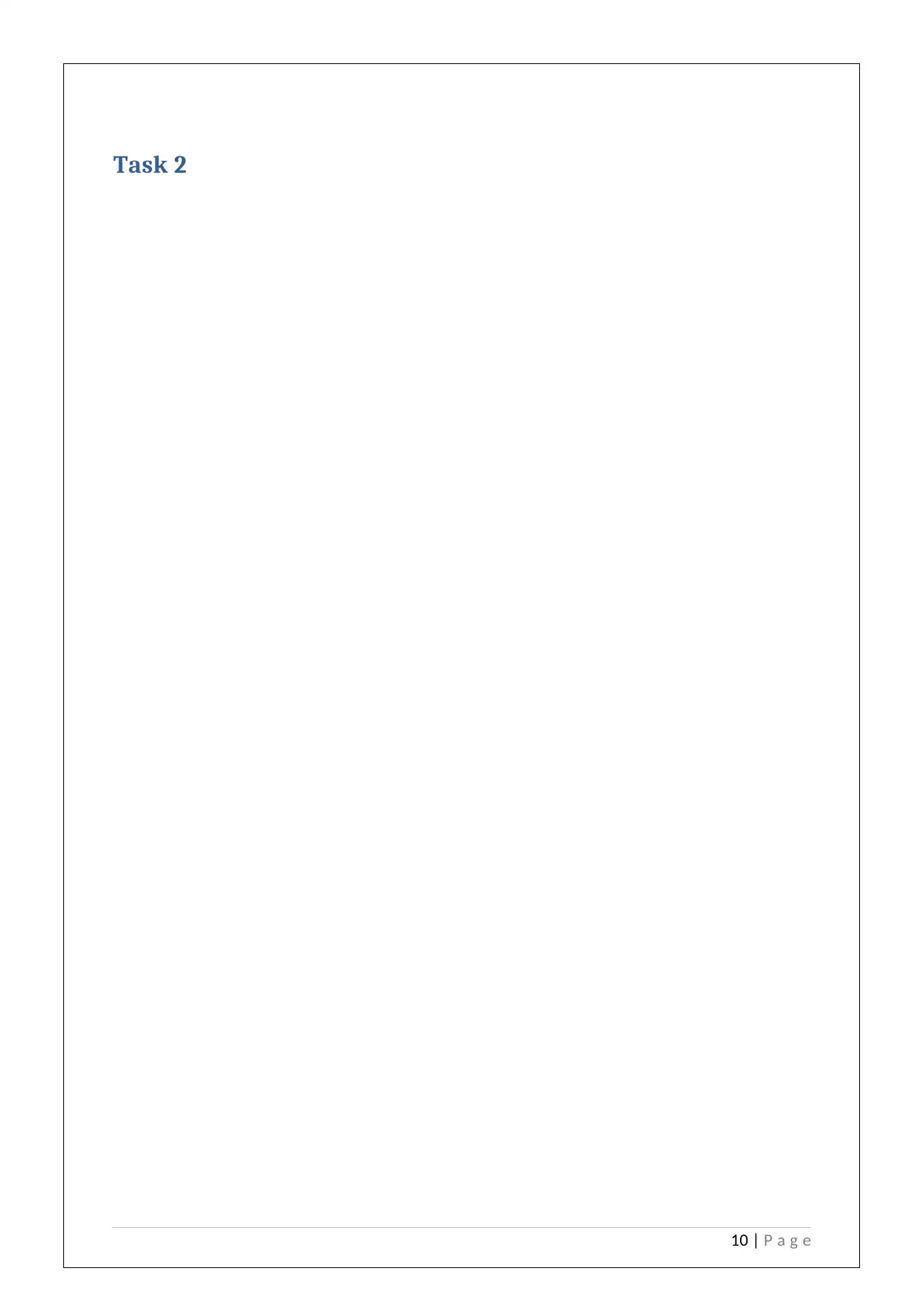
Task 2
10 | P a g e
10 | P a g e
Paraphrase This Document
Need a fresh take? Get an instant paraphrase of this document with our AI Paraphraser
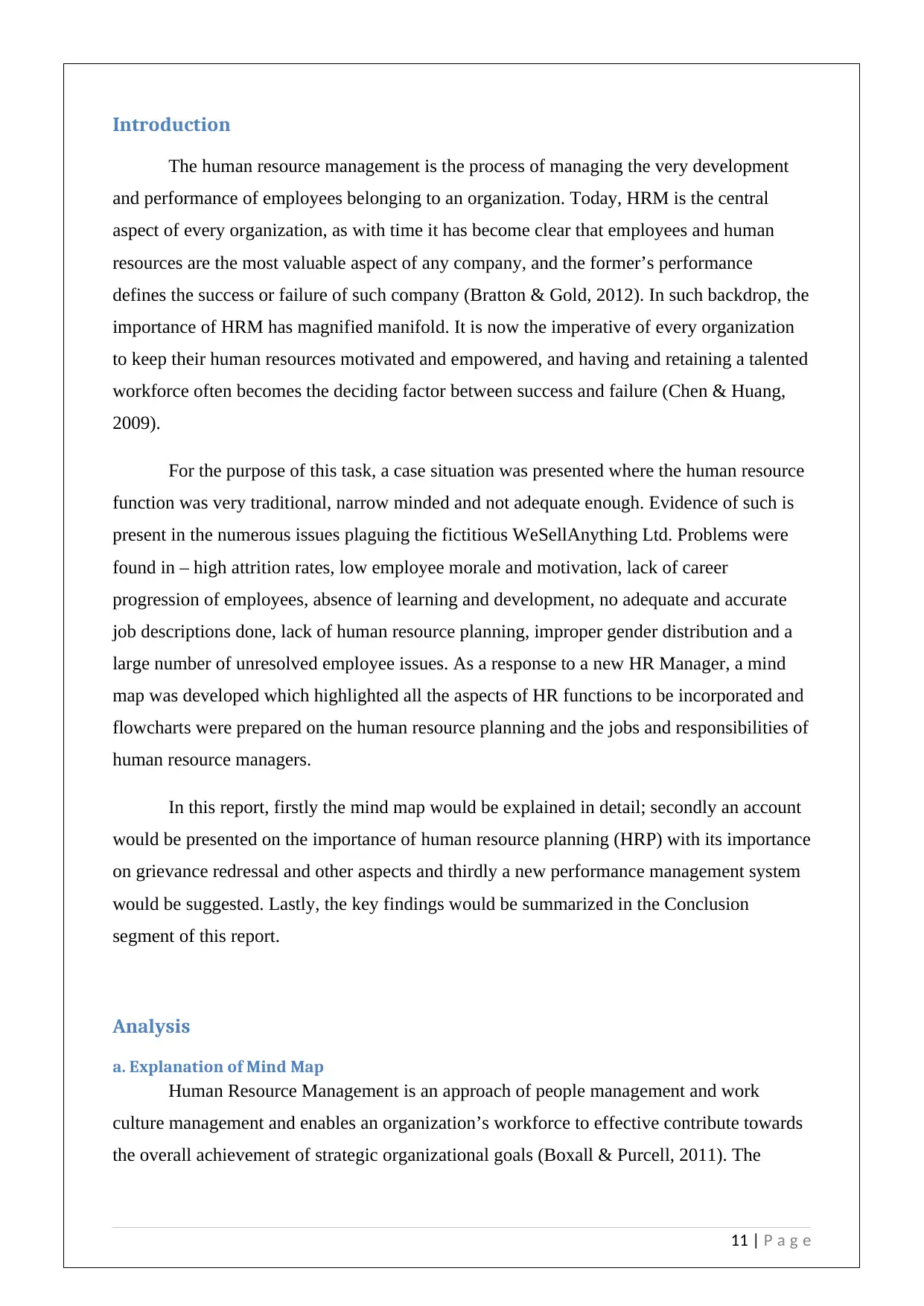
Introduction
The human resource management is the process of managing the very development
and performance of employees belonging to an organization. Today, HRM is the central
aspect of every organization, as with time it has become clear that employees and human
resources are the most valuable aspect of any company, and the former’s performance
defines the success or failure of such company (Bratton & Gold, 2012). In such backdrop, the
importance of HRM has magnified manifold. It is now the imperative of every organization
to keep their human resources motivated and empowered, and having and retaining a talented
workforce often becomes the deciding factor between success and failure (Chen & Huang,
2009).
For the purpose of this task, a case situation was presented where the human resource
function was very traditional, narrow minded and not adequate enough. Evidence of such is
present in the numerous issues plaguing the fictitious WeSellAnything Ltd. Problems were
found in – high attrition rates, low employee morale and motivation, lack of career
progression of employees, absence of learning and development, no adequate and accurate
job descriptions done, lack of human resource planning, improper gender distribution and a
large number of unresolved employee issues. As a response to a new HR Manager, a mind
map was developed which highlighted all the aspects of HR functions to be incorporated and
flowcharts were prepared on the human resource planning and the jobs and responsibilities of
human resource managers.
In this report, firstly the mind map would be explained in detail; secondly an account
would be presented on the importance of human resource planning (HRP) with its importance
on grievance redressal and other aspects and thirdly a new performance management system
would be suggested. Lastly, the key findings would be summarized in the Conclusion
segment of this report.
Analysis
a. Explanation of Mind Map
Human Resource Management is an approach of people management and work
culture management and enables an organization’s workforce to effective contribute towards
the overall achievement of strategic organizational goals (Boxall & Purcell, 2011). The
11 | P a g e
The human resource management is the process of managing the very development
and performance of employees belonging to an organization. Today, HRM is the central
aspect of every organization, as with time it has become clear that employees and human
resources are the most valuable aspect of any company, and the former’s performance
defines the success or failure of such company (Bratton & Gold, 2012). In such backdrop, the
importance of HRM has magnified manifold. It is now the imperative of every organization
to keep their human resources motivated and empowered, and having and retaining a talented
workforce often becomes the deciding factor between success and failure (Chen & Huang,
2009).
For the purpose of this task, a case situation was presented where the human resource
function was very traditional, narrow minded and not adequate enough. Evidence of such is
present in the numerous issues plaguing the fictitious WeSellAnything Ltd. Problems were
found in – high attrition rates, low employee morale and motivation, lack of career
progression of employees, absence of learning and development, no adequate and accurate
job descriptions done, lack of human resource planning, improper gender distribution and a
large number of unresolved employee issues. As a response to a new HR Manager, a mind
map was developed which highlighted all the aspects of HR functions to be incorporated and
flowcharts were prepared on the human resource planning and the jobs and responsibilities of
human resource managers.
In this report, firstly the mind map would be explained in detail; secondly an account
would be presented on the importance of human resource planning (HRP) with its importance
on grievance redressal and other aspects and thirdly a new performance management system
would be suggested. Lastly, the key findings would be summarized in the Conclusion
segment of this report.
Analysis
a. Explanation of Mind Map
Human Resource Management is an approach of people management and work
culture management and enables an organization’s workforce to effective contribute towards
the overall achievement of strategic organizational goals (Boxall & Purcell, 2011). The
11 | P a g e
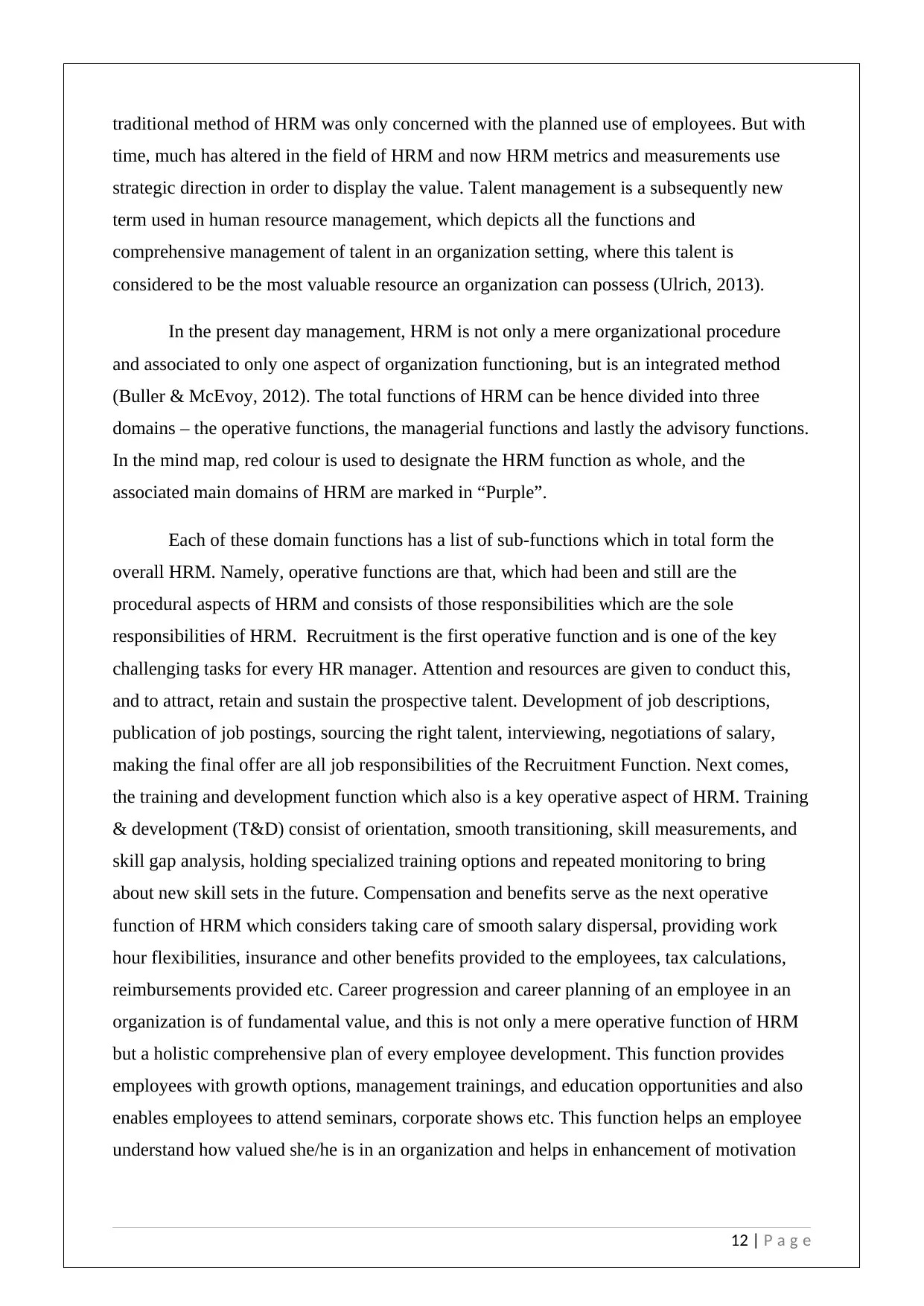
traditional method of HRM was only concerned with the planned use of employees. But with
time, much has altered in the field of HRM and now HRM metrics and measurements use
strategic direction in order to display the value. Talent management is a subsequently new
term used in human resource management, which depicts all the functions and
comprehensive management of talent in an organization setting, where this talent is
considered to be the most valuable resource an organization can possess (Ulrich, 2013).
In the present day management, HRM is not only a mere organizational procedure
and associated to only one aspect of organization functioning, but is an integrated method
(Buller & McEvoy, 2012). The total functions of HRM can be hence divided into three
domains – the operative functions, the managerial functions and lastly the advisory functions.
In the mind map, red colour is used to designate the HRM function as whole, and the
associated main domains of HRM are marked in “Purple”.
Each of these domain functions has a list of sub-functions which in total form the
overall HRM. Namely, operative functions are that, which had been and still are the
procedural aspects of HRM and consists of those responsibilities which are the sole
responsibilities of HRM. Recruitment is the first operative function and is one of the key
challenging tasks for every HR manager. Attention and resources are given to conduct this,
and to attract, retain and sustain the prospective talent. Development of job descriptions,
publication of job postings, sourcing the right talent, interviewing, negotiations of salary,
making the final offer are all job responsibilities of the Recruitment Function. Next comes,
the training and development function which also is a key operative aspect of HRM. Training
& development (T&D) consist of orientation, smooth transitioning, skill measurements, and
skill gap analysis, holding specialized training options and repeated monitoring to bring
about new skill sets in the future. Compensation and benefits serve as the next operative
function of HRM which considers taking care of smooth salary dispersal, providing work
hour flexibilities, insurance and other benefits provided to the employees, tax calculations,
reimbursements provided etc. Career progression and career planning of an employee in an
organization is of fundamental value, and this is not only a mere operative function of HRM
but a holistic comprehensive plan of every employee development. This function provides
employees with growth options, management trainings, and education opportunities and also
enables employees to attend seminars, corporate shows etc. This function helps an employee
understand how valued she/he is in an organization and helps in enhancement of motivation
12 | P a g e
time, much has altered in the field of HRM and now HRM metrics and measurements use
strategic direction in order to display the value. Talent management is a subsequently new
term used in human resource management, which depicts all the functions and
comprehensive management of talent in an organization setting, where this talent is
considered to be the most valuable resource an organization can possess (Ulrich, 2013).
In the present day management, HRM is not only a mere organizational procedure
and associated to only one aspect of organization functioning, but is an integrated method
(Buller & McEvoy, 2012). The total functions of HRM can be hence divided into three
domains – the operative functions, the managerial functions and lastly the advisory functions.
In the mind map, red colour is used to designate the HRM function as whole, and the
associated main domains of HRM are marked in “Purple”.
Each of these domain functions has a list of sub-functions which in total form the
overall HRM. Namely, operative functions are that, which had been and still are the
procedural aspects of HRM and consists of those responsibilities which are the sole
responsibilities of HRM. Recruitment is the first operative function and is one of the key
challenging tasks for every HR manager. Attention and resources are given to conduct this,
and to attract, retain and sustain the prospective talent. Development of job descriptions,
publication of job postings, sourcing the right talent, interviewing, negotiations of salary,
making the final offer are all job responsibilities of the Recruitment Function. Next comes,
the training and development function which also is a key operative aspect of HRM. Training
& development (T&D) consist of orientation, smooth transitioning, skill measurements, and
skill gap analysis, holding specialized training options and repeated monitoring to bring
about new skill sets in the future. Compensation and benefits serve as the next operative
function of HRM which considers taking care of smooth salary dispersal, providing work
hour flexibilities, insurance and other benefits provided to the employees, tax calculations,
reimbursements provided etc. Career progression and career planning of an employee in an
organization is of fundamental value, and this is not only a mere operative function of HRM
but a holistic comprehensive plan of every employee development. This function provides
employees with growth options, management trainings, and education opportunities and also
enables employees to attend seminars, corporate shows etc. This function helps an employee
understand how valued she/he is in an organization and helps in enhancement of motivation
12 | P a g e
⊘ This is a preview!⊘
Do you want full access?
Subscribe today to unlock all pages.

Trusted by 1+ million students worldwide
1 out of 20
Related Documents
Your All-in-One AI-Powered Toolkit for Academic Success.
+13062052269
info@desklib.com
Available 24*7 on WhatsApp / Email
![[object Object]](/_next/static/media/star-bottom.7253800d.svg)
Unlock your academic potential
Copyright © 2020–2025 A2Z Services. All Rights Reserved. Developed and managed by ZUCOL.





